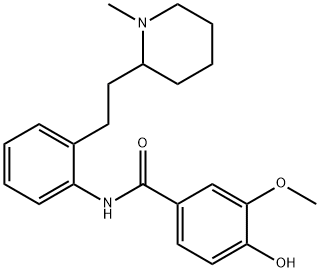81329-71-7
 81329-71-7 結(jié)構(gòu)式
81329-71-7 結(jié)構(gòu)式
基本信息
BMY 40327
Modecainide
3-Methoxy-O-desmethylencainide
Benzamide, 4-hydroxy-3-methoxy-N-[2-[2-(1-methyl-2-piperidinyl)ethyl]phenyl]-
| 報價日期 | 產(chǎn)品編號 | 產(chǎn)品名稱 | CAS號 | 包裝 | 價格 |
| 2025/05/22 | HY-101723 | 莫地卡尼 Modecainide | 81329-71-7 | 1 mg | 1727元 |
| 2025/05/22 | HY-101723 | 莫地卡尼 Modecainide | 81329-71-7 | 10 mM * 1 mLin DMSO | 3080元 |
| 2025/05/22 | HY-101723 | 莫地卡尼 Modecainide | 81329-71-7 | 5 mg | 3800元 |
常見問題列表
The effect of Encainide and its two major metabolites, O-demethylated Encainide (MJ 9444) and 3-O-methoxy Encainide (MJ 14030), on cardiac conduction is studied by recording His bundle potentials in isolated perfused rabbit hearts and Purkinje and muscle conduction in vivo in dog hearts after destruction of the atrioventricular node. Both metabolites are 4 to 15 times more potent than Encainide in slowing conduction through the atria, the AV-node and the His-Purkinje system of the rabbit heart. In the dog, Encainide (0.8-3.2 mg/kg i.v.) slows conduction of extrasystoles in both Purkinje and muscle at all coupling intervals, increases the effective refractory period and the functional refractory period of the Purkinje pathway. MJ 9444 (0.05-0.4 mg/kg) speeds Purkinje conduction of early (less than 300 msec) without affecting or while slowing conduction of late (greater than 350 msec) extrasystoles. Higher doses (0.4-1.6 mg/kg) slows conduction at all intervals. The effective refractory period and the functional refractory period are decreased but in some cases returned to control values at the higher doses. Muscle conduction is slowed at doses of 0.4 mg/kg or more. MJ 14030 (0.05-3.2 mg/kg) has variable effects, behaving like MJ 9444 in three experiments but like the parent compound in two others.